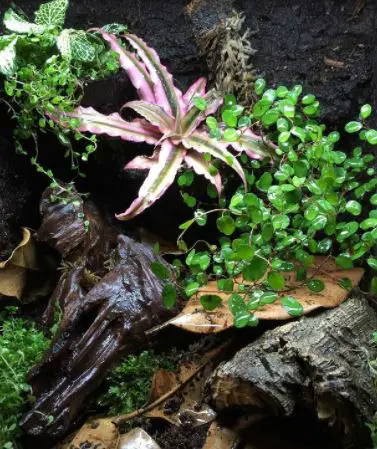How to keep humidity in a reptile tank?
The reptile enthusiast knows that humidity plays an important role in the health of their pet.
Proper humidity levels are necessary to maintain a healthy environment for your animal, but with so many options out there, it can be hard to decide which one is right for you and your budget.
This blog post will explore some of the most popular methods on how to keep humidity in a reptile tank and what type may work best for you!
Related Posts:
- Best Heat Mats for Leopard Gecko
- Top 7 Leopard Gecko Starter Kits for Easy Setup
- Best Substrate for Bearded Dragons
- Best Substrate for Chameleons
- Best Plants for Turtle Tank
How to Keep Humidity in a Reptile Tank?
How to keep humidity in a reptile tank?
Humidity is the amount of water vapor in the air. High humidity can cause respiratory infections and fungal infections in reptiles. Too low humidity can result in dehydration.
Keep humidity at 50-70%. To do this:
- Mist your pet’s cage daily with dechlorinated tap water or well water, and replace the paper towels or newspaper daily.
- Use a reptile fogger to increase humidity in your home. Just mist the cage lightly with dechlorinated water before turning on the fogger and turn off any fans while you are using it to avoid moving dry air around.
- Soak your pet in lukewarm water for 15 minutes daily. Reptiles can absorb some of their hydration this way without drinking at all. Anytime you handle your reptile, do this as well so you don’t stress them out.
- Get a hygrometer to measure the humidity in your home, and keep it near your pet’s cage.
- Buy an automatic mister for your pet’s terrarium. These are especially useful during times when you will be away from home or at night when you won’t be misting the terrarium yourself.
- Use a dehumidifier or air conditioner to maintain humidity, or put your reptile’s cage in front of a humidifier. But make sure that your pet’s cage is not getting wet and rotten from water droplets falling on it.
- Feed your reptile only once daily, at night after the lights are off. This will help keep their metabolism low and conserve water in their bodies, which will result in fewer respiratory infections.
- Use heat lamps instead of heating pads or rocks to provide your pet with warmth. reptiles metabolize better when they are slightly cooler than you are.
- Use a smaller water bowl in the terrarium, and refill it only when it is almost completely dry. This will help you monitor how often your reptile is drinking.
- Use a hydrometer or refractometer to measure your pet’s specific gravity (s.g.), which should be between 1.008 and 1.014 at 70 degrees F. A higher s.g. means your pet is dehydrated, and a lower s.g. means they are drinking too much water and their body fluids could become diluted to the point of organ failure.
- Give your reptile calcium powder or multivitamins daily for overall good health, unless they have special dietary needs that require a different supplement.
- Maintain a temperature gradient by having a warm side and a cool side in the terrarium, with a basking spot available at one end that is between 95-105 degrees F. This will help your pet regulate their body temperature so they won’t have to use as much energy for digestion, which conserves water.
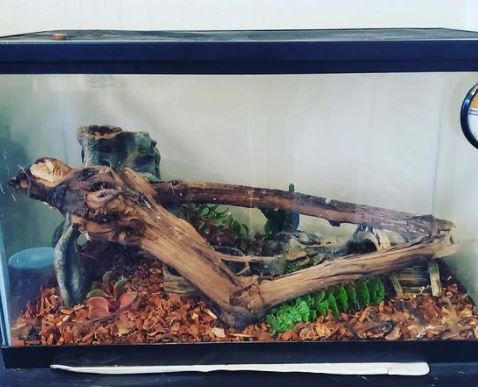
What Does Humidity Do for Reptiles?
Now that you know how to keep humidity in a reptile tank, what does it do for reptiles?
Their skin is made up of scales that are similar to shingles on a roof or bladeless razor blades. They are flat and lay down smooth.
If you have ever worn vinyl before, then you know what happens when the air is dry. When it is dry, the blades/shingles/scales stand up and make your skin feel rough.
When a snake sheds its skin, these scales are in this “stressed” position. They can not lay down until wetted with water. Exposure to light will cause them to dehydrate.
When humidity is too low, the skins can not lay down properly and this leaves microscopic spaces in between the scales, which are perfect places for bacteria or fungus to grow. This can affect your snake’s health by causing respiratory infections.
How Do I Increase Humidity in My Snake Tank?
You may have heard the term ‘humidity’ being mentioned in some snake forums or perhaps you are confused whether you should increase or decrease it for your snake species to be healthy.
I actually faced the same dilemma years ago, so let me tell you what I found out about humidity and snakes.
There are various ways to increase humidity.
However, the most common way is to spray water on the sides of your tanks so they will evaporate and provide moisture into the air. A hygrometer measures this evaporation by calculating how much water is in the air at any given time.
Now that I have told you about humidity, let me give some general recommendations for different snake species.
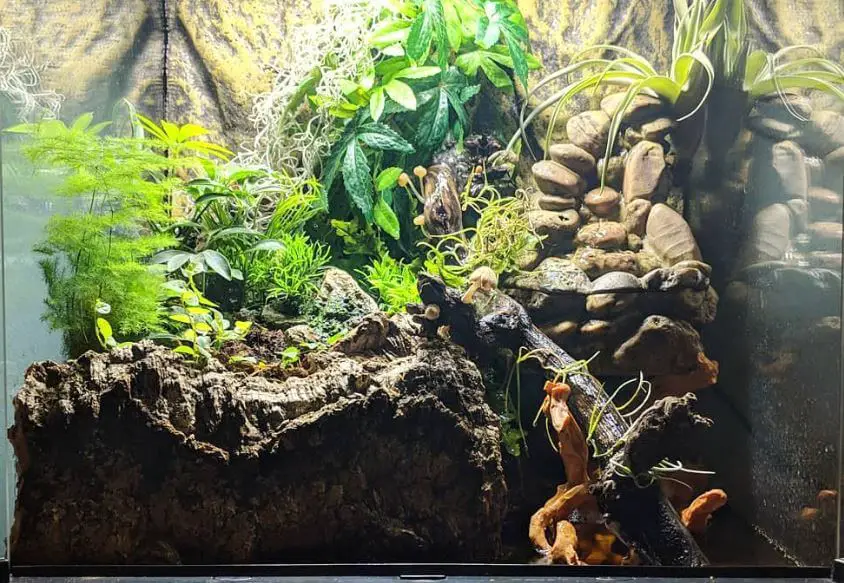
1. Ball Pythons
Ball pythons (Python regius) do not need high humidity at all. In fact, it is best kept between 40-70%.
However, there are some who recommend increasing the humidity to 60% when your ball python has shed.
This is because they like their cages dry and most people use paper towel substrate. The substrate absorbs liquid very well, so it is important to keep your cage dry or you will get a bacterial infection otherwise.
2. Burmese Pythons
Burmese pythons do best at 75% humidity and lower after feeding (from 70-75%).
The air can be quite humid with this species (80-100% humidity). If you notice that your burm has a respiratory infection, decrease the humidity to 60% and increase it again so your snake can clear its lungs.
3. Corn Snakes
Corn snakes (Elaphe guttata) do best at 50-60%.
However, if your corn snake does shed, you may want to decrease the humidity to 40% for about 24 hours.
This species will readily drink from a water bowl or even a wet paper towel.
Ball pythons and Burmese pythons do not drink from standing water, so you don’t have to worry about a water dish. If your snake does not seem interested in the standing water, you can soak it in a bucket of lukewarm water for 20 minutes.
4. Kingsnakes (Lampropeltis) and Milk Snakes (Lampropeltis Triangulum)
Kingsnakes (Lampropeltis) and milk snakes (Lampropeltis triangulum) do well at 60-75%.
The humidity can be quite high with this species. I often get over 90% humidity in their tanks. Do not worry about the substrate getting wet either. It is fine.
The substrate should be damp, but please do not soak it.
5. Reticulated Pythons
Reticulated pythons (Python reticulatus) need a humidity of 60-70% and need a water bowl. You may have to increase the humidity to 80% if your snake is going through a shed.
Desert species such as sand boas, dwarf boas (Boa), and king snakes do not need high humidity like other popular species. It is best to keep it between 40-60%.
Snakes are fascinating creatures. They are beautiful and I hope this has helped you understand them a little better.

How to Keep the Frog Tank Humid?
Frogs are amphibians, which have moist skin or mucous membranes.
Thus, it is important that you learn how to make your frog tank humid.
A common mistake made by frog owners is to believe that the frog’s habitat should be dry and not humid.
This is wrong because frogs are rather comfortable in humid conditions. Remember that you can use these simple tips to keep the frog tank humid.
1. Use a Water Dish With Fresh, Clean Water
Frogs need to have access to fresh, clean water at all times. Leaving your pet frogs without water for more than two days will be clearly dangerous for their health. So it is important that you always keep the water dish filled with fresh, clean water.
2. Clean Your Frog’s Tank Regularly
Frogs are easy to maintain because they are used to living in moist habitats all the time.
While it may be incredibly easy for you to clean their tanks, it is important that you do so by removing all old water and replacing it with a fresh, clean one.
3. Use a Humidifier for the Cold Days
Your frog’s habitat needs to have high humidity during the winter season or at other times when air conditioning is on.
You can place your tank near a heater or use a humidifier inside the room to make sure that your pet frogs are comfortable.
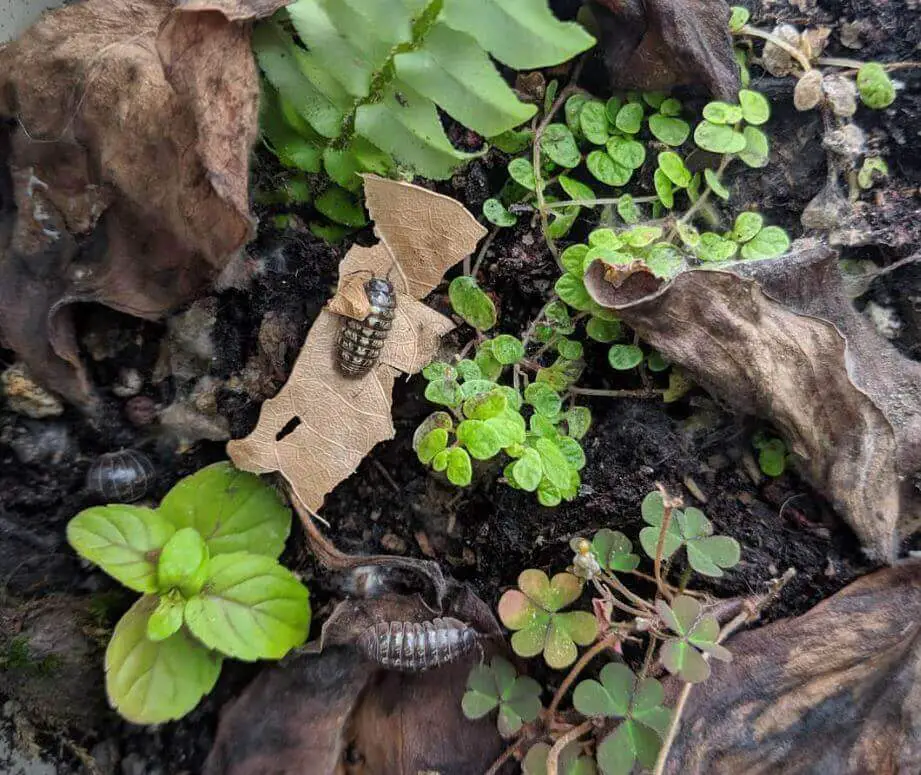
4. Place a Cover on Top of Your Tank
You can put a lid or a cover on the top of your frog tank to prevent it from getting too much light and heat.
Your pet frogs will be more comfortable if you do so.
You should make sure that you leave some openings for air circulation, though. Otherwise, they could get suffocated.
5. Place Rock or Wood Over the Substrate
You can also adjust humidity with how you lay out your frog’s tank.
Make sure that you put rocks and wood here and there in the tank to keep it humid.
You should not use sand because it is too dry for your pet frogs. Remember that live plants will help supply humidity for your pet frogs as well.
6. Increase Humidity by Misting and Spraying
You can also adjust the humidity of the frog tank depending on how you spray and mist your pet frogs with clean water throughout the day or whenever necessary.
Remember that while this is not a good way to maintain the right amount of humidity in your frog’s tank, it is a good way to adjust it.
7. Never Use Chemicals
Never place chemical-based items in your frog tank because they would make the environment toxic for your pet frogs.
Remember that the focus of keeping your frog’s tank humid is to keep the peat moss moist but not wet all the time.
Just remember how to keep the frog tank humid and that you need to keep the substrate moist, not wet all the time.
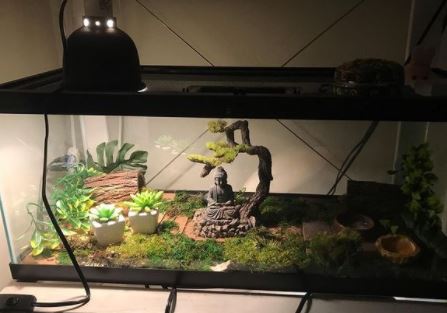
What Are Humidifiers for Reptiles?
Some reptiles can be a bit more difficult to maintain. They need the right temperature, humidity, and lighting.
This is especially true for turtles, geckos, or iguanas that live outside in the wild.
There are many ways to provide your reptile with the proper environment but one of them is using a humidifier for reptiles. Reptile humidifiers are devices that supply the right amount of humidity to your pet’s habitat.
They are usually combined with heating pads or lamps in order to provide additional heat for the animal.
A reptile humidifier comes in many forms, from a misting bottle to an actual device that works like a regular household humidifier. The latter is able to heat up, too, which is another important factor for reptiles that live outside in the wild.
You can also get reptile lamps that will provide warmth and humidity for your pet’s home all at once.
What Is the Difference Between Humidifiers and Vaporizers?
There are two types of humidifiers for reptiles: humidifiers and vaporizers.
A humidifier supplies additional humidity to the air while a vaporizer produces steam that is able to add humidity to your pet’s habitat.
How Do Humidifiers for Reptiles Work?
Reptile humidifiers usually require regular maintenance in order to work properly and provide the right amount of humidity.
The device has to be filled with water or turned on for a few hours in order to get the job done. There is also a timer that automatically turns it off after a certain number of hours, depending on your needs.
Humidifiers for reptiles come with either filters or wicks that absorb the water and release it into the air.
They have to be replaced from time to time in order for the humidifier to work properly. The device will stop releasing humidity when a filter or a wick has dried up and needs replacement.
Most reptile humidifiers require electricity but there are some that run on batteries, which is especially helpful if you’re going away for a week or two.
Reptile humidifiers are made to be used with certain types of reptiles, but you should always check that yours is compatible before making your purchase.
What Are Other Uses of Humidifiers for Reptiles?
There are many ways to use a reptile humidifier in order to provide the proper environment for your pet.
You can put it under a lamp or under the basking spot of your pet.
It can provide enough humidity for you to be able to spray directly into its terrarium, or it can serve as part of a bigger system that includes heat lamps and other devices designed for reptiles.
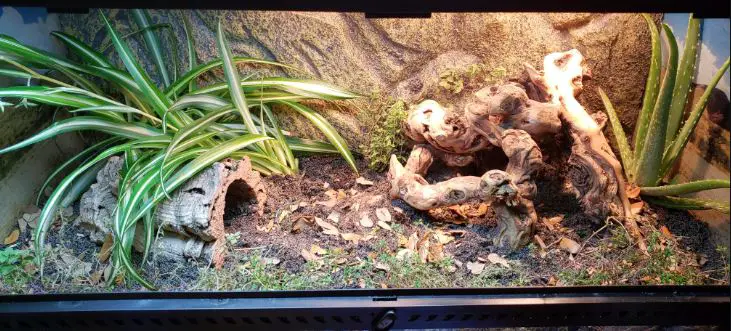
What to Consider When Buying a Humidifier for Reptiles?
There are many different humidifiers for reptiles on the market.
It can be difficult to choose the right one, especially when you have a large collection of animals that requires special conditions.
In order to make your decision easier, here are some of the most important parameters you should keep in mind:
a. Size
Reptile humidifiers come in all shapes and sizes. They are usually compact but some can be pretty bulky.
Make sure you know how much room you have before making your purchase, especially if you plan on putting it under a lamp or next to another appliance.
b. Price
There is a big range of prices for reptile humidifiers. Some of them are more expensive, others are affordable.
The price is dependent on the features included, so make sure you understand what you’re paying for before making your purchase.
c. Energy Source
Reptile humidifiers come with either electricity or battery power depending on their type and size.
If you’re looking to use it under a lamp, make sure that it is compatible with the device you have in mind.
d. Ease of Use
Some reptile humidifiers are more difficult to use than others.
You will have to decide whether you need a device that operates on its own or one that requires constant maintenance.
Conclusion
How to keep humidity in a reptile tank?
It is important to maintain a healthy humidity level in the reptile tank. This will keep the habitat at an optimal temperature and prevent any unwanted health issues for your pet such as respiratory infections or dry, scaly skin.
The best way to achieve this goal is by using a humidifier that can be adjusted based on seasonal changes and maintaining proper ventilation in the room where you house the animal.
With these simple steps to keep humidity in a reptile tank, it should not become difficult to provide adequate levels of moisture and regulate air quality within your enclosure!
Key points for keeping humidity in a reptile tank:
Proper humidity levels are crucial for the health and well-being of your reptile. Whether you have a snake, lizard, turtle, or other reptiles, here are key guidelines to help you maintain suitable humidity in their tank:
1. Know Your Reptile’s Needs:
- Species Variation: Different reptiles have varying humidity requirements. Research your specific species to understand its needs.
2. Suitable Enclosure:
- Appropriate Size: Ensure the enclosure is spacious enough to allow for humidity variation while accommodating your reptile’s growth.
3. Use the Right Substrate:
- Substrate Selection: Choose a substrate that retains moisture well, such as coconut coir, cypress mulch, or a substrate mix. The substrate should allow for burrowing or nesting.
- Proper Depth: Ensure the substrate is deep enough to maintain moisture.
4. Water Source:
- Shallow Water Dish: Provide a shallow water dish for drinking and soaking. Make sure it’s easily accessible and cleaned regularly.
5. Mist the Enclosure:
- Regular Mistings: Mist the enclosure to raise humidity levels and moisten the substrate. Reptiles may drink droplets and absorb moisture through their skin.
- Misting Schedule: Establish a consistent misting schedule. The frequency depends on your reptile’s species and habitat requirements.
6. Hygrometer Installation:
- Use a Hygrometer: Install a reliable hygrometer in the enclosure to monitor humidity levels. Aim for a range appropriate for your reptile’s species.
7. Secure Enclosure Design:
- Proper Cover: Ensure the enclosure has a secure lid or cover to prevent humidity from escaping.
- Ventilation: Maintain suitable ventilation to prevent mold growth, maintain air quality, and avoid excess moisture buildup.
8. Humidity Hiding Spots:
- Create a Humidity Hide: Place a designated hide box filled with damp substrate to offer your reptile a more humid microclimate.
9. Seasonal Adjustments:
- Consider Seasonal Changes: Depending on your location’s climate, you may need to adjust humidity levels to accommodate seasonal variations.
10. Proper Diet and Hydration:
- Hydration Source: Offer clean, fresh water for drinking and soaking.
- Diet: Ensure your reptile’s diet includes foods with appropriate moisture content, such as leafy greens and vegetables.
11. Monitor Health:
- Regular Health Checks: Keep a close eye on your reptile’s behavior and overall health. If you notice signs of dehydration or health concerns, consult a reptile-savvy veterinarian.
12. Adjust to Individual Needs:
- Varied Preferences: Individual reptiles may have slightly different humidity preferences. Monitor your pet’s behavior and make adjustments as necessary.
Conclusion:
Maintaining suitable humidity levels in your reptile’s enclosure is crucial for their health and well-being. By following these guidelines, you can create a comfortable and safe environment, ensuring that your reptile receives the optimal humidity required for their species. Adequate humidity, alongside proper diet, enclosure design, and overall care, plays a significant role in keeping your reptile happy and healthy.
Further Reading:
- Best Turtle Substrate for Your Pet Tank
- Best Substrate for Russian Tortoise
- 6 Best Substrate for Leopard Tortoise
- Best Bioactive Substrate for Leopard Gecko

